Helping you to reach your Dream Destinations
Gurudwara's in Amritsar
The Golden Temple Amritsar India (Sri Harimandir Sahib Amritsar) is not only a central religious place of the Sikhs, but also a symbol of human brotherhood and equality. Everybody, irrespective of cast, creed or race can seek spiritual solace and religious fulfilment without any hindrance. It also represents the distinct identity, glory and heritage of the Sikhs. To pen-down the philosophy, ideology, the inner and outer beauty, as well as the historical legacy of Sri Harimandir Sahib is a momentous task. It is a matter of experience rather than a of description.
As advised by Sri Guru Amar Dass Ji (3rd Sikh Guru), Sri Guru Ram Dass Ji (4th Sikh Guru) started the digging of Amrit Sarovar (Holy Tank) in 1577 A.D., which was later on brick-lined by Sri Guru Arjan Dev Ji (5th Sikh Guru) on December 15, 1588 and He also started the construction of Sri Harimandir Sahib. Sri Guru Granth Sahib (scripture of the Sikhs), after its compilation, was first installed at Sri Harimandir Sahib on August 16, 1604 A.D. A devout Sikh, Baba Budha Ji was appointed its first Head Priest.
The Golden Temple Amritsar India (Sri Harimandir Sahib Amritsar) has a unique Sikh architecture. Built at a level lower than the surrounding land level, The Gurudwara teaches the lesson of egalitarianism and humility. The four entrances of this holy shrine from all four directions signify that people belonging to every walk of life are equally welcome.
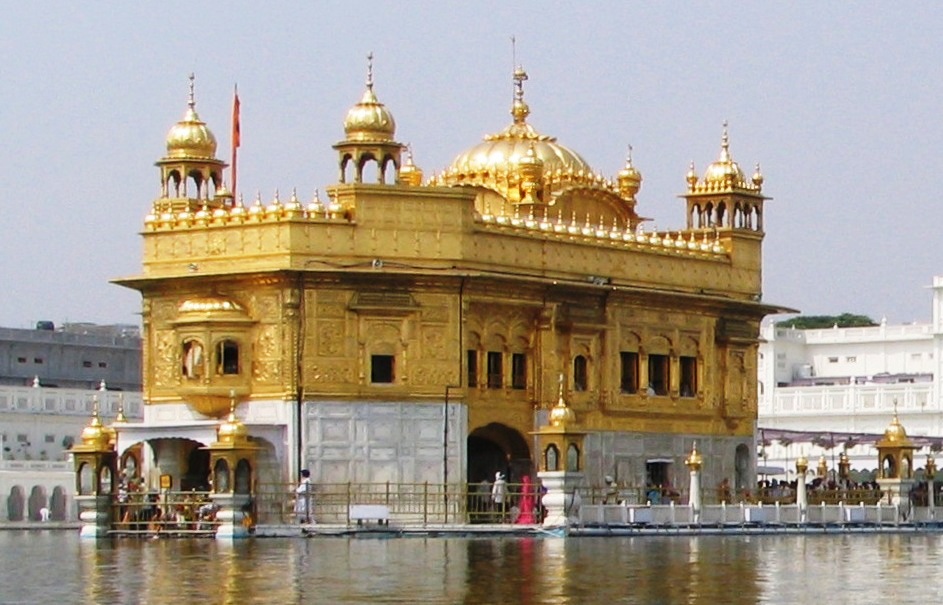
Santokhsar Sahib When (Guru) Ram Das, had not yet ascended to the gaddi, he came here to find out a place for excavation of the holy tank on instructions from Guru Amar Das. When (Guru) Ram Das was getting the place dug, he found a Yogi, meditating. After sometime the Yogi opened his eyes and told Guru Ram Das that he had been meditating here for a long time, waiting for a Guru to give him salvation. He disclosed his name as Santakha and then breathed his last. The tank was then named as Santokhsar. Guru Arjan completed the unfinished work of excavation of tanks - Santokhsar and Amritsar. Baba Buddha was appointed to supervise the work of construction. Santokhsar was completed in 1587-89.
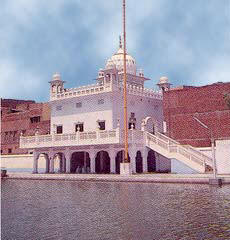
Babeksar Gurudwara Situated on the banks of Bibeksar Sarovar, this lovely Gurudwara was constructed Maharaja Renjith singh. Bibeksar Sahib presents a picturesque scenery and it lies in between Sultanwind and Chativind.
The Sarovar is dug by the 6th Sikh guru, Hargobind for those devotees who wants to be in sheer solitude. He used to sit by the sides of this Sarovar and since the medieval India shown religious nepotism of the Muslim Rulers, the Sikhs were united under Hargobind and used to congregate around this tank.
The day to day affairs of the Gurudwara is now controlled by the Shiromani Gurdwara Parbandhak Committee. Guru ka Langar and a well were added in 1905-06. This gurudwara houses a lovely garden in its premises. On the last Saturday of every month, the Gurudwara would be crowded with devotees, who gather there to participate in the Rainsbai Keertan programme.
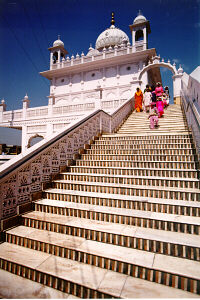
Gurdwara Baba Atal has been raised in the revered memory of Guru Hargobind's 9 year old Sahibzada Baba Atal Rai. It is situated next to Golden Temple. The child was the personification of something wondrous. Through a miracle Baba Atal Rai once revived a dead child. Guru Hargobind was convinced that Sikh religion did not believe in any kind of miracle and that it was an uncalled for interference in the ways of god and the cosmic system. The Guru, therefore, felt annoyed with his son. To atone for the intervention in the divine ways, the child left for his heavenly abode. It is at the point of the terrestrial exist of Baba Atal Rai that a nine storey Gurdwara symbolic of his 9 years of existence was constructed. It is known as Baba Atal.
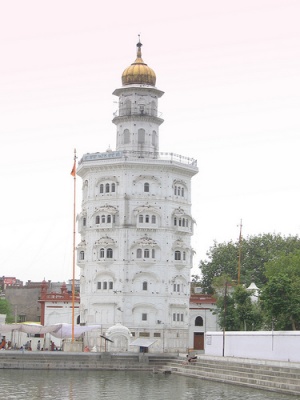
Gurudwara Ramsar Sahib situated on the bank of the pool of the same name. This place is, where Guru Arjun Dev ji for a year or more went into seclusion along with his scribe, the great savant Bhai Gurdas to compile the holy Adi Granth. The sacred volume was completed in 1604 and installed with due honor and ceremonies in the Harmandir Sahib. In this holy book, Guru Arjun Dev collected the hymns of first four Gurus, namely Guru Nanak Dev Jee, Guru Angad Dev Jee, Guru Amar Das Jee, Guru Ram Das Jee and adding his own compositions as well as selections from the writings of the Hindu and Muslim mystic saints.
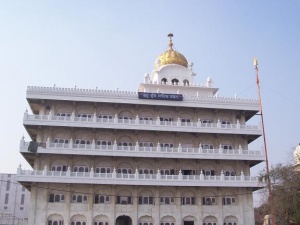
Gurudwara Manji Sahib This gurdwara is dedicated to the fifth Guru, Shri Guru Arjan Dev Ji. He composed the Sukhmani Sahib here. This gurdwara is located on the banks of the sarovar and across the sarovar is Gurdwara Ramsar Sahib.
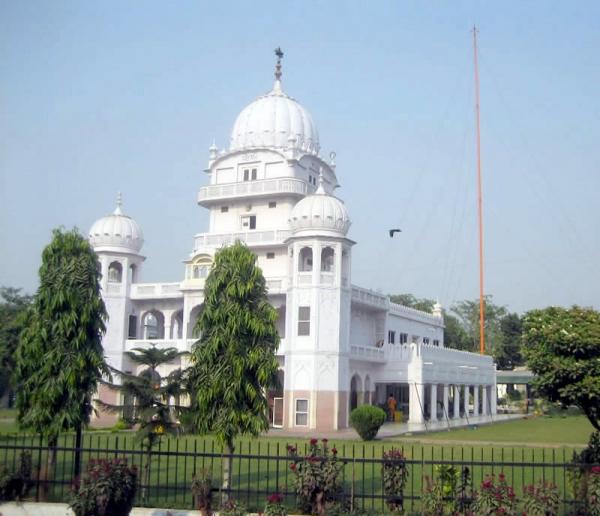
Gurudwara Baba Deep Singh Ji This Gurdwara is dedicated to Baba Deep Singh ji Sahid. He was tall, strong, and uncommonly brave. He had received baptism from the hands of Guru Gobind Singh Ji himself. He was a bold and fearless saint-soldier, ever ready to risk his life for the Panth. Besides being a strong and fearless warrior, he was a great scholar. Along with Bhai Mani Singh, he prepared the final text of Guru Granth Sahib at Damdama Sahib with the help of Shri Guru Gobind Singh ji. he breathed his last in 1757 while fighting with Mugals. At the place where his body was cremated stands a Gurdwara in his memory. It is called Saheed Ganj Baba Deep Singh.
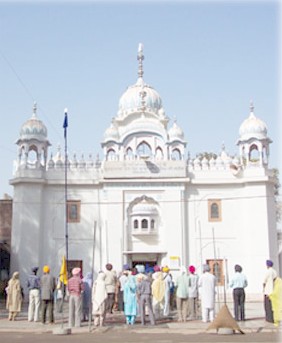
Gurdwaras Chheharta Sahib
Guru ki Vadali is the birthplace of the Sixth Guru, Sri Guru Hargobind Sahib, the son of Guru Arjan Dev Ji. To celebrate the birth of his son, Guru Arjan DevJi constructed a big well at this place. This well had six Persian wheels to draw out the water and thus came to be known as Chheharta, the well with six wheels. This well helped in removing water scarcity in the region and enabled the greening of the fields.
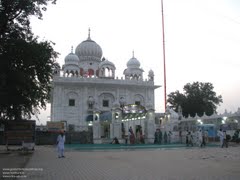
Gurudwara San Sahib Guru Amar Das was forced to leave Goindwal by Datu the son of Guru Angad Dev Jee who was jealous at not being named the Guru by his father. Datu told Guru Amar Das Jee to leave Goindwal, and being the humble person that he was, Guru Amar Das Jee returned to his family village of Basarke. Here the Guru shut himself up in a small hut with a note on the door, 'He who opens this door is no Sikh of mine, nor am I his Guru.' Baba Buddha Sahib made a hole in the wall so as not to go against the Gurus injunction. Once inside they pleaded with the Guru to return to Goindwal as only he was their true beloved Guru and the Sikhs could not live without him. Guru Amar Das finally relented and returned with the Sikhs. The hole in the wall is still preserved today inside the Gurdwara.
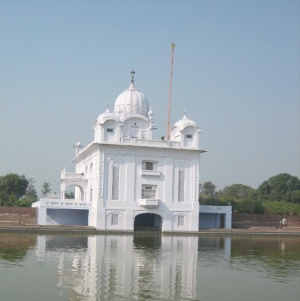
Gurdwara Baba Budha Ji is recognized as one of the great Sikhs of the Guru period. He had the privilege of being blessed by the first six Gurus. He led an ideal Sikh life for more than a hundred years.
Baba Budha Ji was born to Bhai Sugha in 1506 in the village of Kathu Nagal, district Amritsar and was honored as the first Granthi of the Harimandar Sahib (Golden Temple).
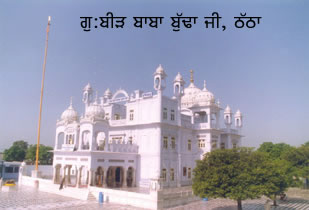
Gurdwara Tarn Taran Sahib Guru Arjan Dev laid the foundation of a Gurdwara in honor of Guru Ram Das and started the excavation of a tank even larger than Amritsar. The Gurdwara Tarn Taran Sahib has one of the largest tanks and resembles the Harmandir Sahib, except that it is built on the side of the tank and has a marble exterior. Guru Arjan Dev also established the first home for lepers in India at Tarn Taran.
Then Visit Khadoor Sahib (16 Kms from Tarn Taran)- Sri Khadur Sahib was the family home of second Guru Sri Guru Angad Dev Ji. The Guru settled here with his wife Mata Khivi and raised their three children here. Sri Guru Angad Dev Ji established his religious center here and spent the rest of his life at Khadur Sahib. Here Shri Guru Angad Dev appointed Guru Amar Das as his successor and the third Guru. A grand Gurudwara Khaddi Sahib, has been constructed here, in memory of Guru Amar Das.
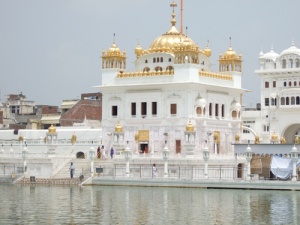
Gurdwara Goindwal Sahib Visit Goindwal Sahib (12 Kms from Khadur Sahib), visit Gurdwara Shri Baoli Sahib- This was the first centre of Sikhism and was established by Sri Guru Amar Das Ji. The Hindus went on pilgrimage to Hardwar and Benaras but the Sikhs needed a place of their own. Understanding this, Sri Guru Amar Das Ji purchased the land and personally helped in the construction of the Gurdwara and Baoli (well) with 84 steps leading down to it.
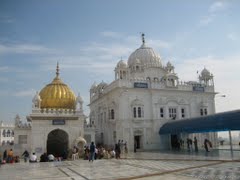
You can visit Amritsar throughout the year although best time is from March to August. Winters here are very cold so it's best to plan your trip well in advance. To find the Cheap Flights to India and Cheap Flights to Amritsar visit us on Amritsar Travel and Tours.